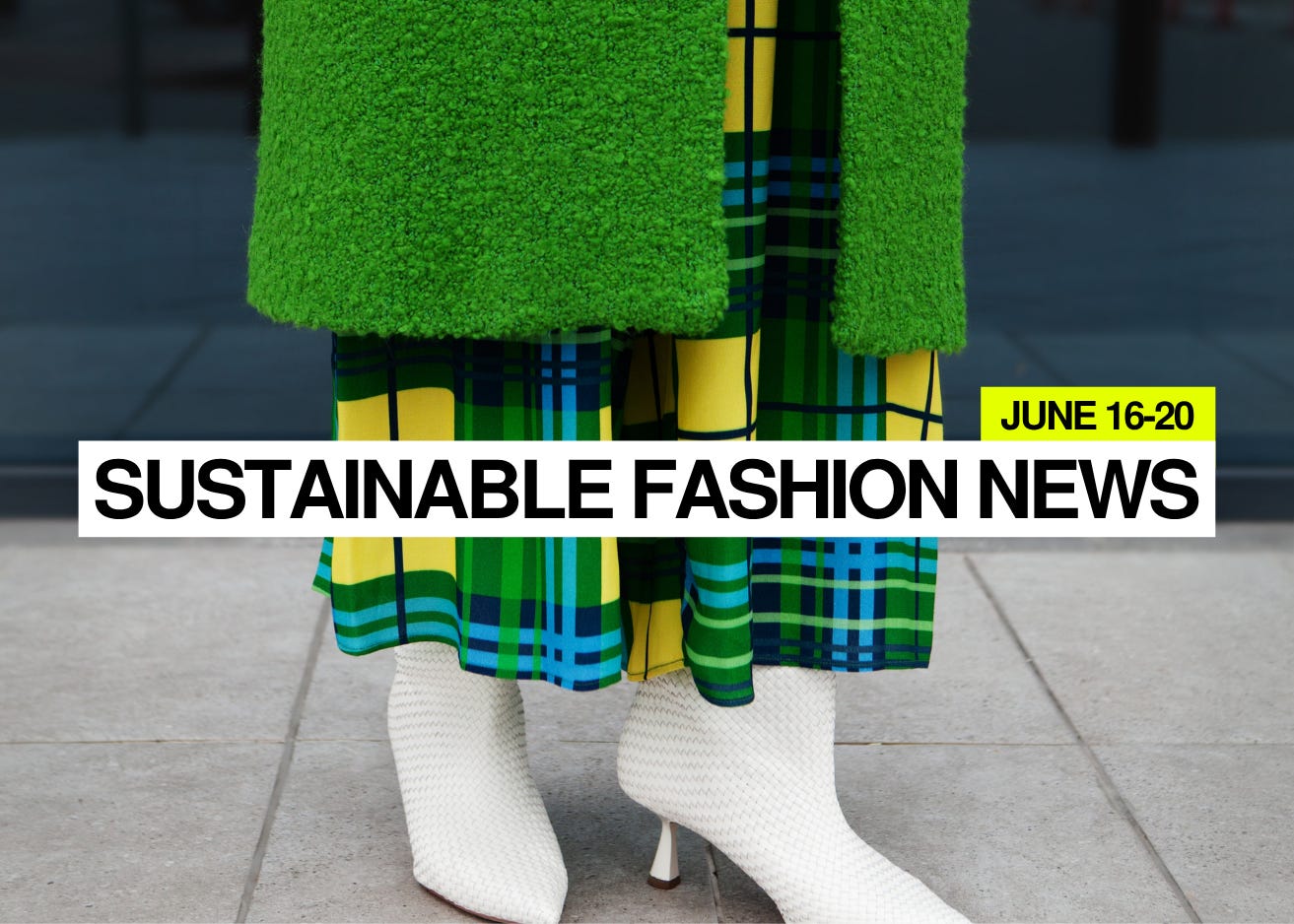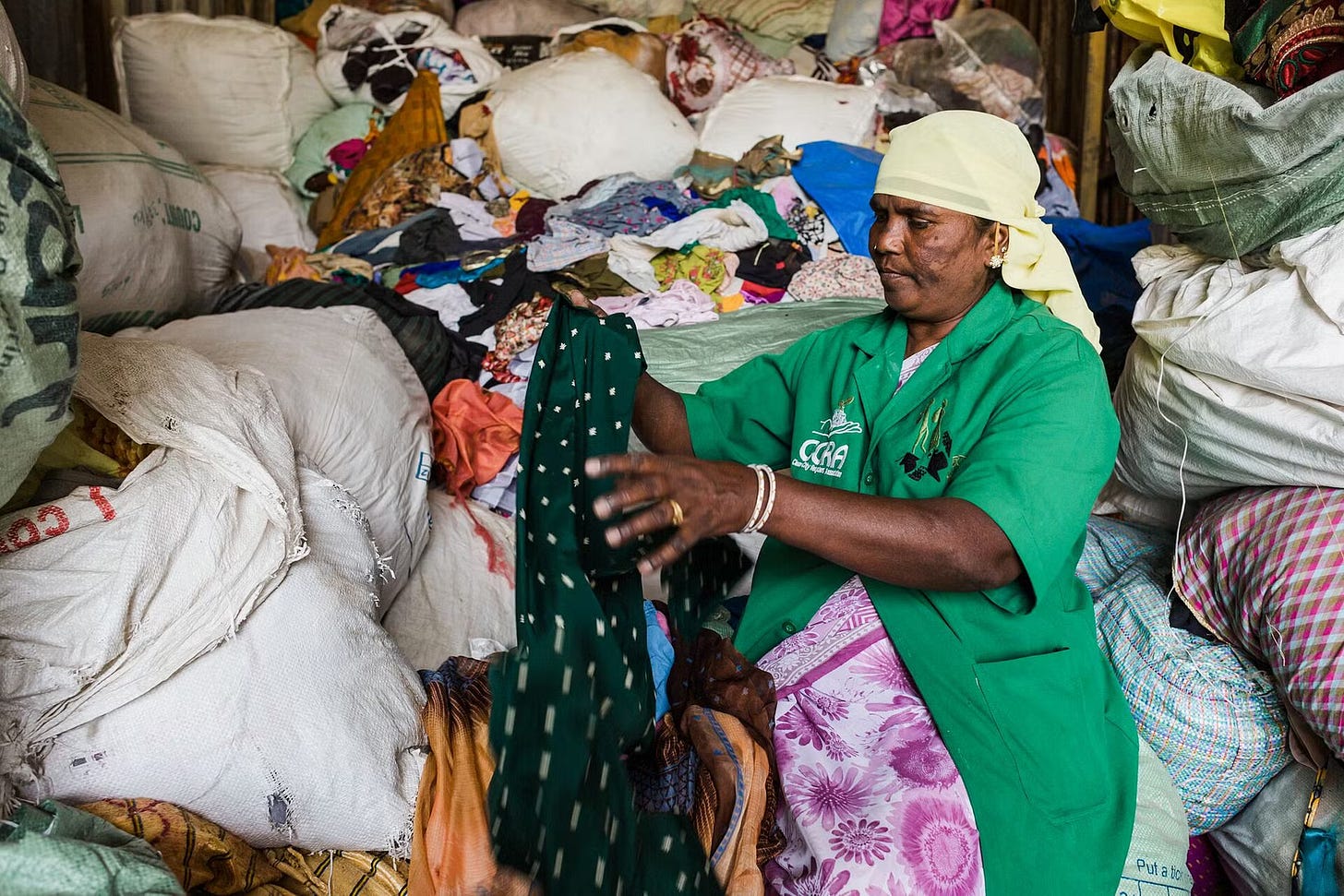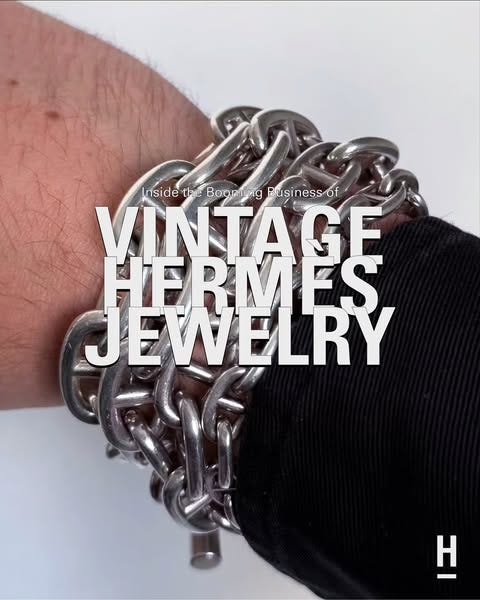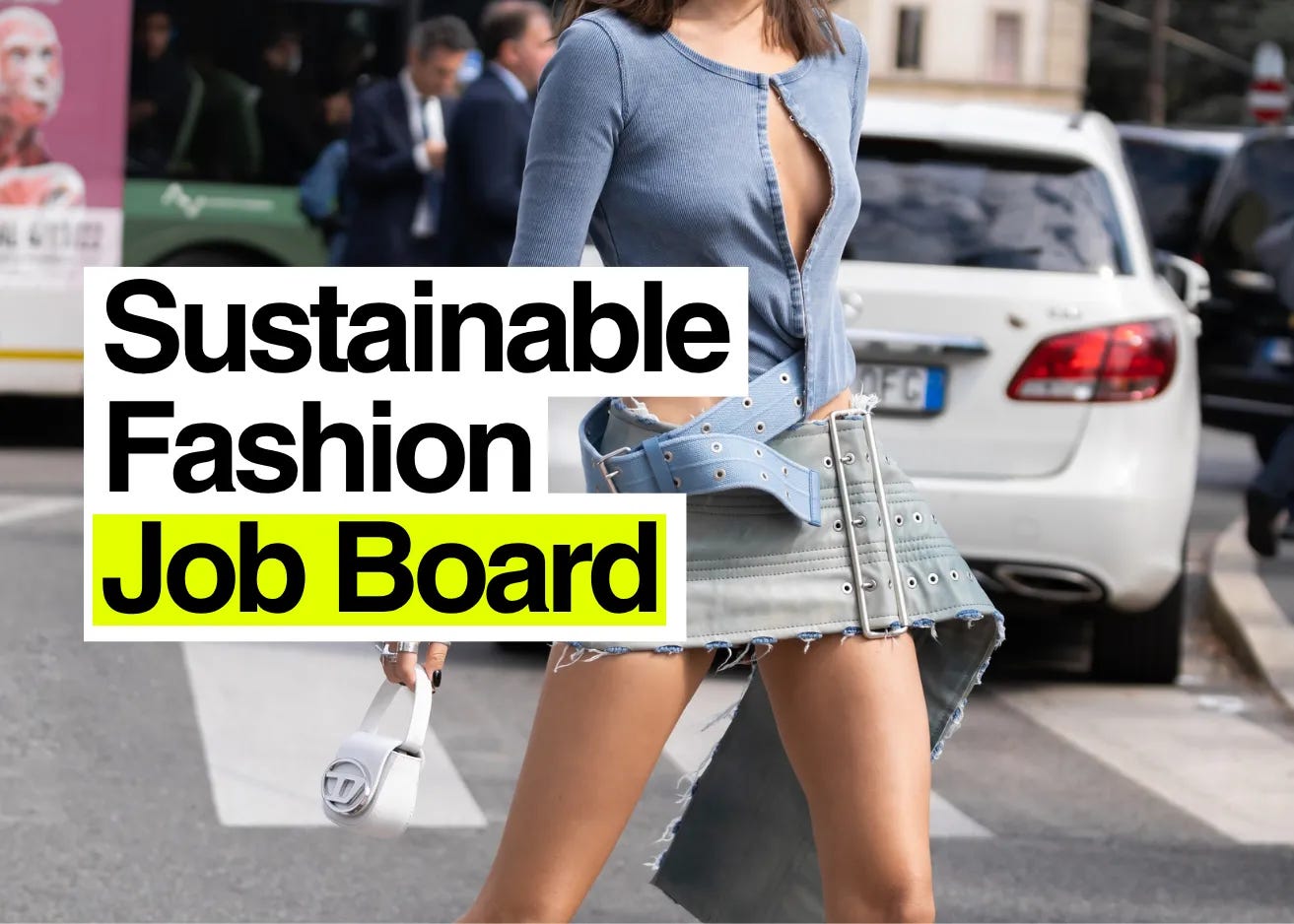Wait… the EU is ditching the Green Claims Directive?!
Plus: 32% of Gen Z shoppers are afraid of being judged for the brands they buy, and more!
Welcome to Week/End, your quick-hit guide to the need-to-know sustainable fashion news shaping the industry. Read by strategy leads, design teams, and sustainability consultants at top global brands, but written like it’s for your group chat. Week/End is your shortcut to context, clarity, and cultural fluency, without the overwhelm.
In today’s Week/End recap:
The EU just pulled the plug on the Green Claims Directive (yes, really).
Circulose signed its first brand deal with Mango since Renewcell's bankruptcy.
Fashion for Good launched Fibre Club 2.0 with AltMat.
32% of Gen Z shoppers say they’re afraid of being judged for the brands they buy.
Greenpeace found UK textile waste in Ghana’s wetlands—but recyclers say the story is misleading.
…and more!
👀 Wanna work in sustainable fashion?
New roles just dropped from PVH Corp, Vestiaire Collective, Patagonia, Alaïa + more.
We’re tracking sustainability-specific roles in climate, compliance, traceability, and impact—updated weekly from brands around the world.
🎧 Before we dive in, here’s this week’s Burnout Banger — the playlist we’re building for when the work gets heavy, the inbox won’t quit, and you need a four-minute mental vacation.
This week’s pick comes from me (is that cheating?). Best played loud when you’re ready to leave the stress behind.
What’s your go-to burnout banger? Drop it in the comments or hit reply and let me know.
The EU Is Ditching the Green Claims Directive
What’s going on:
During a press briefing on Friday, Commission spokesperson Maciej Berestecki announced that in its “current context” the Commission plans to withdraw the proposed Green Claims Directive, which would have required brands to scientifically substantiate environmental claims like “climate neutral” and “made with recycled materials” before marketing them. The law also aimed to crack down on unregulated third-party eco labels by mandating third-party verification.
The details:
This decision comes after heavy pushback from the center-right European People’s Party (EPP), who, in a letter to Environment Commissioner Jessika Roswall, said the proposal was too costly for small businesses and lacked a full impact assessment. The EPP warned it could subject up to 30 million micro-enterprises to burdensome compliance.

While Parliament negotiators say they still want to proceed, the Commission hasn’t confirmed whether it will revise or scrap the proposal. A formal decision still needs approval from the College of Commissioners.

Some context:
This doesn’t mean all greenwashing rules are off the table. The Empowering Consumers for the Green Transition Directive, , adopted in 2024, still bans vague or misleading green claims, prohibits unverified sustainability logos, and outlaws offset-only marketing language like “climate neutral.” It also cracks down on fake durability claims — for example, suggesting a product will last longer than it actually does. This law focuses on protecting consumers at the point of sale and will be enforced starting September 2026.
What made the Green Claims Directive different is that it would’ve gone further, targeting what brands are allowed to say in the first place. It was designed to force companies to scientifically prove their environmental claims — like “made from recycled materials” — through third-party verification, and to clean up the complexity of over 200+ unregulated eco-labels across the EU. While the Empowering Consumers Directive limits what brands can say, the Green Claims Directive would have required them to prove it before saying anything at all. One regulates the messaging. The other was about backing it up.
Now that the Green Claims Directive is likely off the table, the EU still has rules, just without the strongest enforcement tool it was building.
So, what’s next?
Negotiations over the Green Claims Directive were set to start Monday. Parliament remains ready to engage, but unless the Commission reverses course or offers a revised proposal, this may mark a significant step back in the EU’s green marketing crackdown.
Greenpeace Found UK Textile Waste in Ghana’s Protected Wetlands—But Recyclers Say the Story’s Misleading
What happened:
An investigation by Unearthed and Greenpeace Africa found textile waste piling up in Ghana’s protected Densu Delta wetlands. Reporters found unlined dumpsites spilling into lagoons and rivers, threatening endangered species, contaminating local fishing grounds, and violating international conservation agreements.
The details:
Reporters traced labels from H&M, Zara, M&S, Primark, George (Asda), and Next to dumps across Accra, including Ramsar-designated conservation zones. Ghana receives ~15 million used garments every week. Officials say 40% of each bale is unsellable. With only one engineered landfill, the rest ends up in waterways, farmland, or informal dumps.
Who’s responsible?
The clothes were discarded by UK consumers, but who’s ultimately accountable for where they ended up?
Primark denied authorizing any unsold or take-back clothing to be shipped to Ghana or anywhere in Africa. It said no single brand can solve the problem alone and called for collective industry-wide action.
H&M acknowledged the company’s role in contributing to textile waste, especially in regions with inadequate waste infrastructure. It cited industry-wide gaps in end-of-life and recycling solutions.
M&S denied sending excess stock abroad and pointed to its in-store take-back programs and new clothing repair services as part of its broader sustainability strategy.
George (Asda) said its production and fashion seasons haven’t increased in the last decade. The brand supports exploring extended producer responsibility (EPR), provided funds go toward UK infrastructure.
Zara (Inditex) confirmed it still releases two fashion seasons annually, with a 37% synthetic fiber mix. It supports mandatory EPR and emphasized the need for unified legislation to create a circular system.
Next did not respond.
Bottom line: Everyone agrees the system is broken, but no one’s taking direct responsibility. There’s still no clear chain of custody once clothes leave the UK.
Industry pushback:
The UK’s Textile Recycling Association (TRA) called the investigation misleading. CEO Alan Wheeler questioned why ultra-fast fashion brands like Shein or Temu weren’t mentioned and cited GIZ data showing only 1.2% of imports are true waste. He also noted that much of the discarded material in Kantamanto comes from tailoring scraps, not just unsold or low-quality clothes.

The TRA defended the secondhand trade as vital to Ghana’s economy, supporting 2.5 million jobs and supplying 95% of clothing in the country. The group continues to call for UK legislation on EPR that includes financial support for waste infrastructure in receiving countries.
Do reports like this move the needle or muddy the waters?
Some say we need these headlines to hold the industry accountable. Others argue they oversimplify messy realities, villainize imperfect players, and make it harder for real solutions to gain traction.
Have a different perspective? Let’s discuss in the comments!
What caught Week/End readers’ attention last week?
Canada’s new greenwashing guidelines require all environmental claims—especially net-zero goals—to be backed by credible evidence or risk penalties.
Gotham Foundry launched a NYC-based innovation hub to scale regenerative materials, backed by $45M in public funding.
Not one of the 65 brands reviewed by BHRRC includes garment workers or trade unions in its decarbonization plans.
WBCSD released updated circularity metrics for fashion, aligning with ESRS E5 and adding tools for measuring design, materials, and social impact.
COLLABORATIONS & INITIATIVES
The T2T Alliance released a position paper urging the EU to set mandatory recycled content thresholds in the upcoming ESPR textile regulation: 10% by 2028, 15% by 2030, and 30% by 2035. They’re also calling for post-industrial waste to count toward targets, stricter disclosure rules, and a verified tracking system.
Circulose signed its first brand deal since Renewcell’s bankruptcy, with Mango committing to use the material at scale through a licensing agreement. The deal includes design support and supply chain integration, part of Circulose’s reboot strategy to move beyond capsules and lock in long-term demand.
Fashion for Good launched a new Fibre Club partnership with AltMat, the India-based startup turning agricultural waste into next-gen fiber. Following last year’s pilot with Circ, the updated model brings together mills and manufacturers to reduce risk and streamline adoption, so brands can commit to minimum orders without reinventing their supply chains.
A textile waste pilot in Bengaluru, run by local waste pickers, is now scaling to 12 cities across India, offering one model for how circularity and social equity can scale together. Backed by the H&M Foundation and led by Hasiru Dala and Circular Apparel Innovation Factory, the system diverts post-consumer clothing from landfills through a network of 16 sorting centers and a central textile recovery facility. It’s already hit 55% of its 800,000 kg diversion target and supported over 400 informal workers. The model is now being replicated nationwide with municipal support and shared ownership between NGOs, waste picker collectives, and city authorities.
BUSINESS STRATEGY
Better Cotton announced plans to formally become a regenerative agriculture standard within the next year. The shift will include revised Principles & Criteria, updated training for certifiers, and a new outcome-based reporting framework. Pilots are already underway, and the full rollout is expected to align farmers with widely accepted regenerative practices starting in 2026.
ACCOUNTABILTY
The Fashion Workers Act just took effect in New York, requiring model agencies to cap commissions, stop charging exploitative fees, and obtain written consent before using a model’s likeness via AI. It’s the first law of its kind in the U.S. and fashion’s labor reckoning might just be getting started.
INNOVATION
Woolmark and COLOURizd launched a new yarn-dyeing process that uses just 0.5L of water per kg—down from the typical 60–120L—and skips bleach, acids, and wastewater entirely.
REPORTS
Canopy’s latest Hot Button Report shows 70% of man-made cellulosic fiber (like viscose and lyocell) producers now meet its highest sourcing standards—up from zero in 2016. That means most major suppliers have moved away from high-risk forest sourcing and toward recycled or lower-impact feedstocks, as pressure from 550+ brands reshapes the market.
A new report from Keele University and the League of Artisans found that most fashion and homeware brands don’t track the environmental impact of artisan-made goods—despite relying on them for products like rugs, embroidery, and leatherwork. Just 14% include these workshops in Scope 3 emissions targets, and only 12% monitor air quality, even in high-risk sites. The CRAFTED Index names Gucci, Hermès, and The Row as leaders, while calling out Dunelm, Wayfair, and La Redoute for near-zero oversight.
So what do all these headlines actually mean?
Starting next week, we’re launching The Monthly Forecast, a high-level breakdown of what this month’s biggest stories really signal for the future of sustainability in fashion.
If Week/End is your shortcut to staying up-to-date, the Forecast is your shortcut to staying ahead!
► Lightspeed surveyed 2,000 U.S. and Canadian consumers and found that 32% of Gen Z shoppers fear being judged for buying from the “wrong” brands—a mix of purpose and peer pressure that’s reshaping how they shop. While 92% say they’re at least somewhat intentional with their purchases, only 40% are very intentional, and just 32% say values-based shopping is a new behavior. Price and quality still lead, but 45% say brand values will matter more in future purchases.
► British Vogue launched Vogue Values, a year-long editorial campaign backed by Nike and eBay, focusing on sustainability, women’s health, and representation in fashion. The first activation, Fashion is for Everyone, addresses clothing poverty through new partnerships with Smart Works and Give Your Best. At the same time, Teen Vogue is doubling down on sustainability across its fashion coverage, integrating secondhand into shoots, calling out greenwashing, and rethinking how trends are framed. I spoke with Style Director Alyssa Hardy about what this shift means behind the scenes.
► Vintage Hermès silver jewelry is the latest item caught in the resale gold rush, with 1930s–60s pieces now flipping for up to $17,000. Demand is being driven by Japan’s collector market and Instagram dealers, as buyers chase heritage, quality, and scarcity over newness.
If you're job hunting in sustainability, skip the LinkedIn scroll. The SFF Job Board is updated weekly with roles exclusively focused on fashion, impact, innovation, and ESG.
New this week:
PVH Corp | Director, Product Compliance
Amsterdam, Netherlands | On-Site・Full-Time
↳ Apply hereVestiaire Collective | Climate Strategy Lead (1 Year Fixed Term)
Paris, France | Hybrid · Contract
↳ Apply hereAlaïa | Sustainability Intern
Paris, France | On-Site・Internship
↳ Apply herePatagonia | Community Marketing & Impact Intern France (f/m/d) – 6 months
Annecy, France | Internship
↳ Apply here
📌 Paid subscribers get full access to the full job board + updates every week.
Because this is still a fashion newsletter…
Wondering what to wear to your next job interview, Zoom meeting, or panel appearance? Fashion people are calling desaturated pink the new power neutral—feminine without the frill, sharp without trying too hard.
👉 How to wear it without looking like a cupcake.
🔗 Let’s stay in touch: LinkedIn | Instagram
📣 Wanna reach 6K+ professionals in fashion and sustainability? Sponsor the newsletter!
📩 Love Week/End? Forward it to a friend—or sign up here to get it every Sunday!





















Thank you for this informative newsletter. You didn’t mention France’s new law which seems hopeful.
I think it’s great the big brands are being pressured but a lot of what I see as an outerwear designer is a lack of interest in good quality clothes. People are happy to wear shapeless polyester like they are happy to eat plastic food.
We need refine our senses again.